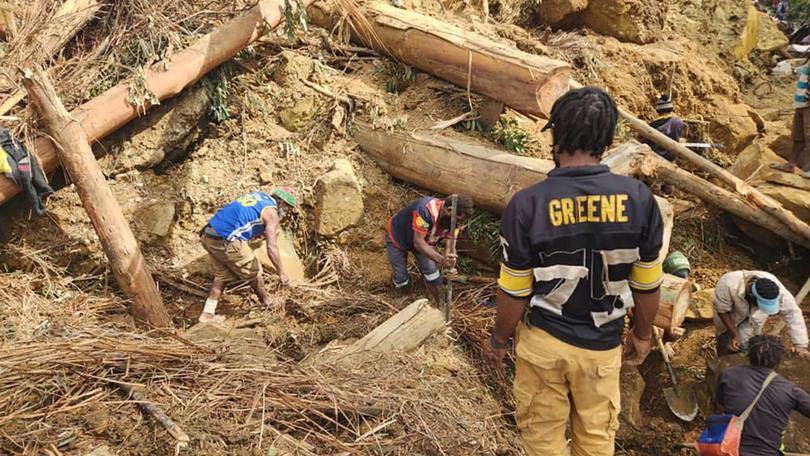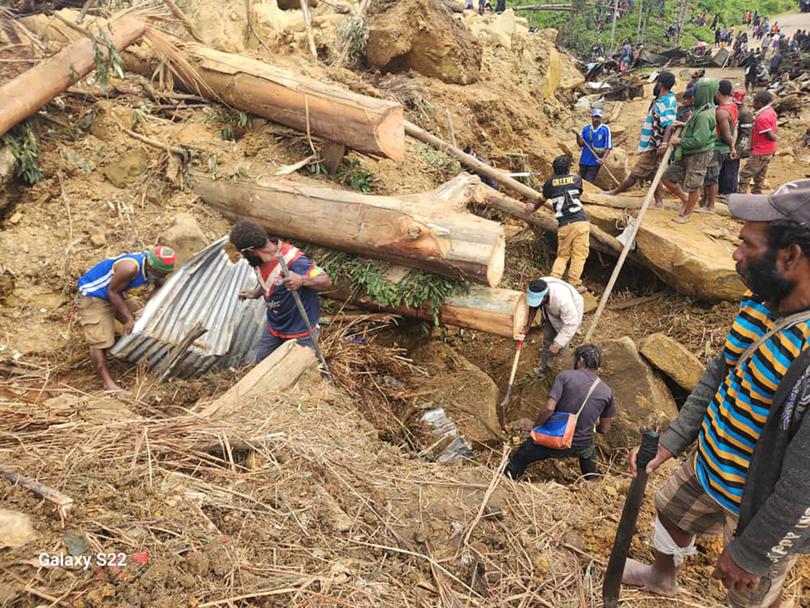Papua New Guinea landslide disaster intensifies as thousands ordered to evacuate amid fears of second collapse

Papua New Guinea has ordered thousands of residents to evacuate from the path of a still-active landslide after parts of a mountain collapsed burying at least 2000 people.
Officials said the odds of finding survivors were slim, even as relief teams have trickled into the difficult-to-access northern Enga region of the Pacific nation since Friday.
Heavy equipment and aid have been slow to arrive because of the treacherous terrain and tribal unrest in the remote area, forcing the military to escort confovys of relief teams.
Sign up to The Nightly's newsletters.
Get the first look at the digital newspaper, curated daily stories and breaking headlines delivered to your inbox.
By continuing you agree to our Terms and Privacy Policy.Residents have been using shovels and their bare hands to search for survivors under the mass of boulders, earth and splintered trees which devastated the area when a limestone mountainside sheared away Friday.
The blanket of debris has become more unstable with recent rain and streams trapped between the ground and rubble.
“The landslide area is very unstable. When we’re up there, we’re regularly hearing big explosions where the mountain is, there are still rocks and debris coming down,” Enga province disaster committee chairperson Sandis Tsaka told Reuters.
The U.N. agency has officials at the scene in Enga province helping shelter 1,600 displaced people. The agency estimates 670 villagers died, while Papua New Guinea’s government has told the United Nations it thinks more than 2,000 people were buried. Six bodies had been retrieved from the rubble by Tuesday.
The total affected population, including those needing possible evacuation and relocation, was estimated at 7,849.
An International Organisation for Migration official said that a bridge had collapsed on the main highway to the site, forcing aid convoys to take a longer route.

Papua New Guinea regularly experiences landslides and natural disasters that rarely make headlines, but this is one of the most devastating ones it has seen in recent years.
The relief operation was extraordinarily complicated, said Nicholas Booth, resident representative at the United Nations Development Programme, with the terrain continuing to move.
“It means that now, the area that’s been affected by the landslide is greater than it was at the beginning. We don’t know how it will develop, but that’s the nature of the geology in PNG,” he said.
IOM’s Itayi Viriri said that aid teams were having to proceed cautiously to prevent “another disaster”.
“We still have water underneath the rubble so that is making the whole area quite uneven so it ensures all response efforts have to be done in a very careful manner,” he told a Geneva briefing.
A long-running tribal conflict has made it harder for aid workers to access the site, Booth said. Eight people were killed and 30 houses torched in fighting on Saturday.
A total of 150 structures were estimated to have been buried by the landslide.
The U.N. said on Tuesday that immediate needs included clean water, food, clothing, shelter items, kitchen utensils, medicine and hygiene kits and psychosocial support.
Provincial authorities have requested the international community to send engineers to carry out a geohazard assessment, the U.N. said in a statement.
The differing fatality estimates reflect the difficulty in getting an accurate population count. The nation’s last credible census was in 2000 and a 2022 voter roll does not include those under 18.
Such estimates should be treated with “great caution”, Booth said.
“Most people remain trapped under that rubble and it’s just not possible at this stage to make a very scientific, verified estimate,” he said. “But it’s going to be a very high number of casualties. We have to be prepared for that.”
